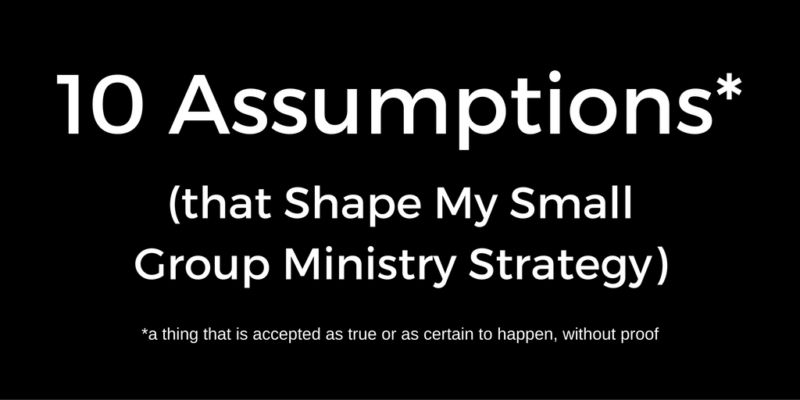I’ve Just Added Two New Assumptions to My List of Assumptions
 We've talked many times about assumptions. If you've been along for much of this adventure, you've probably read more than your share of articles on assumptions. If the idea of assumptions is unfamiliar to you, I've linked to a few of my favorites below.
We've talked many times about assumptions. If you've been along for much of this adventure, you've probably read more than your share of articles on assumptions. If the idea of assumptions is unfamiliar to you, I've linked to a few of my favorites below.
I'm thinking about my assumptions about small group ministry today because of an email I received from a reader yesterday. Their question in the email was so obviously the wrong question that it caused to me to wonder why in the world they are doing what they're doing. And that caused me to reflect on my assumptions.
Here is a list of my assumptions (about small group ministry):
- There is no problem-free solution. Wise leaders simply choose the set of problems they’d rather have. See also, The Pursuit of Problem-Free.
- Unconnected people are one tough thing away from not being at our church. Every delay at connecting them puts many of them in jeopardy. See also,What’s Your Urgency Level for Connecting People?
- The optimal environment for life-change is a small group. Circles, not rows. See also, Essential Ingredients for Life-Change.
- Joining a group in a stranger’s living room is the second scariest move (preceded only by coming to church for the first time). This makes a safe and familiar on-campus first step out of the auditorium a key to connecting people. See also, How to Calm an Unconnected Person’s Second Greatest Fear.
- The people with the most connections inside the church have the fewest connections outside the church. Conversely, the people with the least connections inside the church have the most connections outside the church. This is an understanding that makes HOST a great idea. See also, Exponential Outreach.
- Every group of ten has a relative shepherd (and most adults can quickly identify the person they’d be willing to follow). In a Malcolm Gladwell sense, everyone can see very quickly who the leader should be. See also, How to Connect People No One Else is Connecting.
- The leader of a group only needs to be a step or two ahead of group members. Even Jesus didn’t look for Jesus Jr. See also, Top 5 Signs Your Church Really Wants to Be a Church OF Groups.
- *I need to make it as easy as possible to begin "leading" and nearly automatic that the new "leader" step onto the leadership development conveyor belt. See also, Steve Gladen on Saddleback's Leadership Development Pathway.
- Whatever we want the members of a group to experience, the leader has to experience first. This makes coaching or mentoring an essential ingredient for any small group strategy. See also, The End in Mind for an Effective Coaching Structure.
- *Prioritizing the launch of new groups connects the largest number of unconnected people. Prioritizing the needs of existing groups connects the fewest unconnected people. See also, Are You Prioritizing the Launch of New Groups?
What question was so obviously the wrong question?
The essence of the question was, "Have you written anything on how to best connect people with (existing) leaders? One of my greatest issues right now is connecting people on a Sunday with (existing) leaders."
What makes that the wrong question? Easy. Emphasizing connecting unconnected people with existing leaders (who already have groups), leads to connecting the fewest unconnected people. Prioritizing the launch of new groups (via a small group connection, GroupLink, etc.) leads to the connecting the largest number of unconnected people.
*New assumptions to the list.
What do you think? Have a question? Want to argue? You can click here to jump into the conversation.
Further reading on assumptions:
- 5 Assumptions That Stunt Small Group Ministry Growth
- 7 Assumptions That Shape My Small Group Strategy
- Ready to Go on an Assumption Hunt? (Great idea on how to do it from Gary Hamel).
- The Danger of Unexamined Assumptions
- Is It Time to Change Your Strategy
- Andy Stanley on Assumptions
- Testing Long-Held Assumptions

